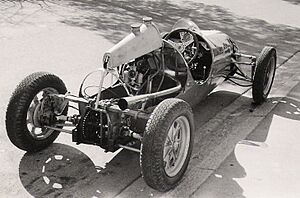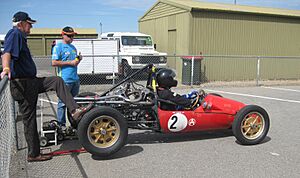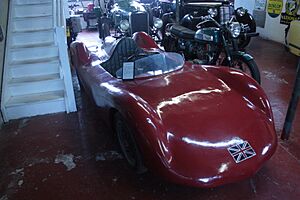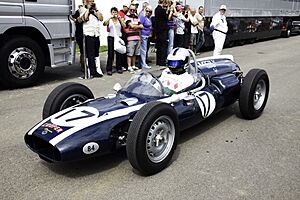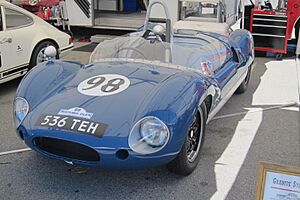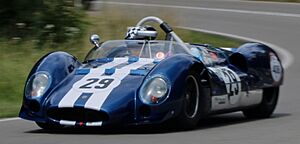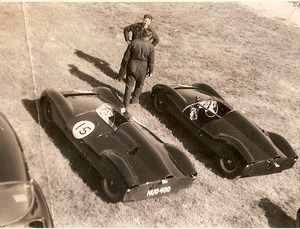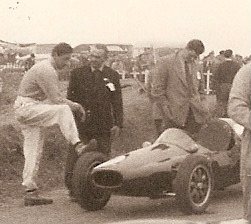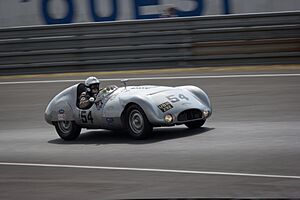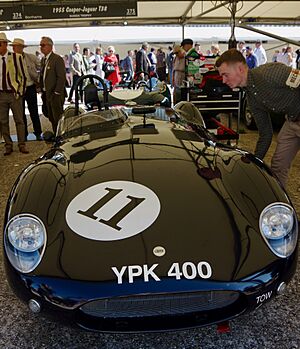Cooper Car Company facts for kids
 |
|
| Full name | Cooper Car Company |
|---|---|
| Base | Surbiton, Surrey, United Kingdom |
| Founder(s) | Charles Cooper John Cooper |
| Noted drivers | |
| Formula One World Championship career | |
| First entry | 1950 Monaco Grand Prix |
| Races entered | 129 |
| Constructors' Championships |
2 (1959, 1960) |
| Drivers' Championships |
2 (1959, 1960) |
| Race victories | 16 |
| Pole positions | 11 |
| Fastest laps | 14 |
| Final entry | 1969 Monaco Grand Prix |
The Cooper Car Company was a British car maker. It was started in December 1947 by Charles Cooper and his son John Cooper. They began building race cars in a small garage in Surbiton, England.
In the 1950s and early 1960s, Cooper cars became very famous. Their special design, with the engine placed behind the driver, changed motor racing forever. Cooper cars won championships in Formula One and raced in the Indianapolis 500. Their Mini Cooper also became a legend in rally racing. Today, the Cooper name is still used on special versions of the Mini cars, which are now made by BMW.
Contents
How Cooper Cars Started
The very first cars built by the Coopers were small, single-seat racing cars. They were designed for the 500-cc Formula Three series. These cars were driven by John Cooper and his friend Eric Brandon. They used JAP motorcycle engines.
After World War II, materials were hard to find. So, the first cars were made by joining two old Fiat Topolino car fronts together. John Cooper said the idea of putting the engine behind the driver was just practical at the time. Since they used a motorcycle engine, it was easier to have it at the back, connected by a chain. This design, though not entirely new, helped make Cooper cars famous.
The car was called the Cooper 500. It was very successful in races and hillclimbs. Many drivers, including Stirling Moss and Bernie Ecclestone, wanted one. This led to the Cooper Car Company being officially started. Cooper became the first company after the war to build and sell racing cars to private drivers.
Cooper built hundreds of these small cars in the 1940s and 1950s. They won 64 out of 78 major races in the F3 category between 1951 and 1954. This success helped the company grow. In 1950, a modified Cooper 500 (a T12 model) raced in the 1950 Monaco Grand Prix. This was the first time a rear-engined car appeared in a Grand Prix race since WWII.
In 1952, Cooper introduced the front-engined Formula Two Cooper Bristol. Famous drivers like Juan Manuel Fangio and Mike Hawthorn drove these cars. This helped Cooper's reputation grow even more.
Later, in 1955, Cooper started building rear-engined sports cars. These cars, called "Bobtails," used a modified Coventry Climax engine. The Coopers realized that having the engine in the middle made the car more stable and better at using its power. So, they decided to build a single-seater version for Formula 2 races.
The Rear-Engined Revolution
In 1957, Jack Brabham surprised everyone. He finished sixth at the 1957 Monaco Grand Prix in a rear-engined Formula 1 Cooper. Then, Stirling Moss won the 1958 Argentine Grand Prix in a Cooper. Maurice Trintignant won the next race at Monaco. The racing world was amazed, and a big change began.
In 1959, Brabham and the Cooper team made history. They were the first to win the Formula One World Championship with a rear-engined car. They won again in 1960. After this, every Formula One World Champion has driven a car with the engine behind the driver.
The person behind this revolutionary car was Owen Maddock. He was a designer at Cooper Car Company. Maddock was known for his clever ideas. He helped make British racing cars dominant in the 1960s. He once joked about a design with "every tube bent," and Charles Cooper loved it, saying, "That's it!"
In 1960, Jack Brabham took a championship-winning Cooper T53 to the Indianapolis Motor Speedway. He then entered the famous 500-mile race in a special Cooper T54. At first, other teams made fun of the small European car. But it ran very well, finishing ninth. It took a few years, but the Indianapolis teams soon realized that rear-engined cars were the future. Since Jim Clark won in a rear-engined Lotus in 1965, every Indianapolis 500 winner has had the engine in the back. The revolution started by the small Cooper 500 was complete.
Once all car makers started building mid-engined racers, Cooper's simple designs were overtaken by newer, more complex technology. The Cooper team's success began to fade. This was made worse when John Cooper was badly hurt in a car accident in 1963. His father, Charles Cooper, passed away in 1964.
Final Years of Cooper Racing
After his father's death, John Cooper sold the Formula One team in April 1965. The team moved to a new factory in Byfleet. Cooper's 1965 season was not very good. At the end of the year, their top driver, Bruce McLaren, left to build his own F1 car.
For 1966, Cooper made a new car, the Cooper-Maserati. It used a 3-litre Maserati engine. This engine was old, heavy, and used a lot of fuel. The new Cooper T81 chassis built for it was also quite large. Three of these cars were sold to private teams, but they did not have much success.
Jochen Rindt was still with the team. Cooper was lucky to get Richie Ginther to drive the second car. Ginther was later called back by Honda. Then, John Surtees joined the team after leaving Ferrari. Surtees helped improve the car. He won the last race of the year in Mexico. This was a great win for the team.
For 1967, Surtees left, and Pedro Rodríguez joined Rindt. Rodríguez won the first race of 1967 in South Africa. This was Cooper's last Grand Prix victory. The team's performance went down for the rest of the season. A lighter car, the T86, did not help much. Rindt was unhappy and left the team before the end of the season.
In 1968, Cooper used a 3-litre V-12 engine from BRM. A changed version of the T86, called the T86B, was built for this engine. Drivers Ludovico Scarfiotti and Brian Redman drove for the team. They finished well in a few races because other cars had problems. But then Scarfiotti died in a hill climb accident, and Redman had a bad crash. Cooper used different drivers for the rest of the season, but the T86B was no longer competitive.
The Cooper Car Company started to close down in 1969. They could not find money to build a new car. Many workers lost their jobs. Frank Boyles, who built cars for customers, was the last to leave. He went on to design and race his own cars, winning many races.
In total, Cooper cars raced in 129 Formula One World Championship events over nine years. They won 16 races.
Besides Formula One cars, Cooper also made Formula Junior cars. These included the T52, T56, T59, and T67 models. Ken Tyrrell ran a very successful team with these cars. Later, Ken Tyrrell tested Jackie Stewart in a Cooper T72 Formula Three car. This test was the start of a famous partnership in motorsport.
John Cooper retired and later started a garage business in Ferring, England, in 1971. This garage sold parts to make Mini Coopers faster. The garage was sold in 1986.
In October 2009, Mike Cooper, John Cooper's son, started Cooper Bikes. This is the bicycle part of the Cooper Car Company.
Mini Car Legacy
As Cooper's Formula One team faced challenges, the Mini car became hugely popular. John Cooper helped develop the Mini Cooper in 1961. It was a more powerful version of the original Alec Issigonis-designed Mini.
The Mini Cooper became a champion in saloon car and rally races throughout the 1960s. It won many championships and the famous Monte Carlo rallies in 1964, 1965, and 1967.
Today, different versions of the Mini still carry the Cooper name. The current BMW MINI, made since 2001, has Cooper and Cooper S models. There are also special John Cooper Works versions that offer even higher performance.
Images for kids



